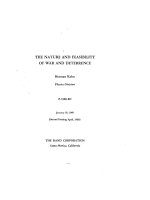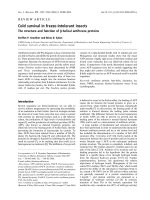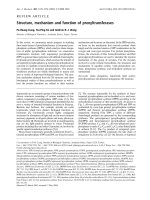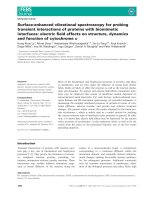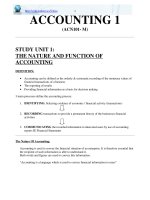ACCOUNTING 1 (ACN101- M) THE NATURE AND FUNCTION OF ACCOUNTING doc
Bạn đang xem bản rút gọn của tài liệu. Xem và tải ngay bản đầy đủ của tài liệu tại đây (134.27 KB, 30 trang )
/>ACCOUNTING 1
(ACN101- M)
STUDY UNIT 1:
THE NATURE AND FUNCTION OF
ACCOUNTING
DEFINITION:
• Accounting can be defined as the orderly & systematic recording of the monetary values of
financial transactions of a business
• The reporting of results
• Providing financial information as a basis for decision making
3 main processes define the accounting process:
1. IDENTIFYING: Selecting evidence of economic / financial activity (transactions)
2. RECORDING transactions to provide a permanent history of the businesses financial
activities
3. COMMUNICATING the recorded information to interested users by use of accounting
reports IE Financial Statements
The Nature Of Accounting:
Accounting is used to convey the financial situation of an enterprise. It is therefore essential that
the recipient of such information is able to understand it.
Both words and figures are used to convey this information.
“Accounting is a language which is used to convey financial information to users”
1
/>Forms Of Ownership:
1. Sole Trader / Proprietor
2. Close Corporation
3. Company
4. Partnership
5. Non – profit Organizations
Users of Financial Information:
Financial information is required / used for analysis by:
1. INVESTORS:
The Shareholders with a Financial Interest in the business
2. CREDITORS: The lenders of money, merchandise and services also have a Financial
Interest in the business
3. EMPLOYEES:
Regarding job security and wage negotiations and predictions for future employment
4. GOVERNMENT:
Regarding taxes, and also for statistical purposes. Also used as an indication for Macro-
Economic planning
5. MANAGEMENT:
In order to plan and set new goals for future economic growth
FIELDS OF ACCOUNTING:
Financial Accounting VS Management Accounting
• Recording transactions and preparing
financial statements regarding the entity
as a whole
• GAAP (Generally Accepted Accounting
Practices) standards ensure comparability
of financial statements between
businesses
• Provides financial information for specific
purposes
• Used by management for decision making
• Used to assist management reach financial
goals
2
/>STUDY UNIT 2:
THE NATURE OF ACCOUNTING THEORY
p.13
ACCOUNTING PRINCIPLES:
1. Accrual Principle : (WHEN?)
The transaction must be recorded in the financial period it occurs, whether or not the cash has
been received or paid
2. Consistency: (SAME)
Once a method has been chosen it must be maintained. If said policy is changed, this must be
reflected in the financial statements of the business
3. Prudence: (MODERATION)
When there is uncertainty about the value of an element of event, use the effect that has the
most Unfavorable effect on the business
4. Materiality: (SEPARATE MATERIAL TRANSACTIONS)
All material transactions should be recorded separately in the financial statements.
Immaterial transactions must be aggregated.
(Material means substantial / of relatively large importance.)
IE: Buying a building = Material Transaction
Buying a stapler = Immaterial Transaction
5. Matching:
This refers to the Double Entry system
Expenses that create an income (IE – buying goods for resale), must be recorded in the same
financial period.
6. Realisations:
An income / expense / transaction, should only be brought into account once it is relatively
certain that that the collectability / payability of that transaction is certain.
ACCOUNTING POLICY & DISCLOSURE THEREOF:
A set of decisions that determine how the enterprise will treat the same type of transactions to
achieve consistency, which has to be disclosed in the financial statements.
EG: The enterprise needs to disclose on which basis it deals with the depreciation of property and
equipment etc.
GENERALLY ACCEPTED ACCOUNTING PRACTICE (GAAP)
This is a foundation that acts as a general framework to encompass accounting concepts, principles,
methods and procedures.
3
/>According to GAAP there are two main underlying assumptions with regards to financial
statements:
1. The Accrual Basis*
2. The Going Concern *
The four main qualitive characteristics are:
1. Understandability
2. Relevance
3. Reliability
4. Comparability
The elements of financial statements are:
• Elements to measure FINANCIAL POSITION:
1. Assets
2. Liabilities Balance Sheet Accounts
3. Equity
• Elements to measure PROFITABILITY / FINANCIAL RESULT
1. Incomes Nominal Accounts (Expenditure Accounts)
2. Expenses
4
/>STUDY UNIT 3:
THE FINANCIAL POSITION
p.21
THE FINANCIAL POSITION: The Assets & Interests of the entity at a GIVEN TIME
(BALANCE SHEET)
ASSETS = INTEREST
1. EQUITY + 2. LIABILITIES
“Owners financial interest
”
“Creditors financial interest”
.:. ASSETS = EQUITY + LIABILITIES
AND
EQUITY = ASSETS - LIABILITIES
NET WORTH:
The enterprises NET WORTH is the difference between the values of the assets owned, less the
liabilities it has incurred.
ASSETS – LIABILITIES = NET WORTH (“EQUITY”)
5
/>STUDY UNIT 4:
THE FINANCIAL RESULT p.29
THE FINANCIAL RESULT: The PROFIT or LOSS incurred by the enterprise OVER
A SPECIFIC PERIOD.
(INCOME STATEMENT)
FINANCIAL RESULT = INCOME – LESS EXPENDITURE
= NET PROFIT / LOSS
ASSETS = EQUITY + LIABILITIES
(Capital + Income – Expenditure)
6
/>STUDY UNIT 5:
THE DOUBLE ENTRY SYSTEM p.39
ENTERING INFORMATION INTO THE LEDGER:
1. What is the effect of the transaction going to be on the BAE?
2. Identify the accounts involved
3. Determine which should be credited and which should be debited
4. Ensure the debited amount = credited amount
5. Indicate date of transaction
6. Indicate name if CONTRA ledger account
7. Indicate the folio number of the subsidiary journal
TRANSACTIONS AFFECTING ASSETS & INTERESTS: p40
• Capital Contributions:
T.Tom draws 13 000 from his personal bank a/c and deposits as capital for Fix N Mat
ASSETS = EQUITY + LIABILITIES
Bank = Capital
+130 000 = +130 000
• Acquisition of Loans:
Fix N Mat obtains a loan from ABC Bank for R25 000
ASSETS = EQUITY + LIABILITIES
Bank = Capital + Loan: ABC Bank
+25 000 = + +25 000
• Purchase of Assets for Cash:
Fix N Mat bought Equipment from XY Furnishers for R100 000, paid by cheque
ASSETS = EQUITY + LIABILITIES
Bank Equipment = Capital + Loan: ABC Bank
-100 000 +100 000 =
• Buying goods on credit:
Fix N Mat bought furniture on Credit from Joc Limited, R2000
ASSETS = EQUITY + LIABILITIES
Bank Furniture = Capital + (Loan: ABC Bank + Joc Ltd)
+2 000 = +2 000
• Payments to Creditors:
Fix N Mat paid Joc Ltd ‘s account of R2 000
ASSETS = EQUITY + LIABILITIES
Bank Furniture = Capital + (Loan: ABC Bank + Joc Ltd)
-2 000 = -2 000
7
/>TRANSACTIONS AFFECTING INCOME & EXPENDITURE: P46
• Income: CASH
Fix N Mat provided services for client S. Silver and received cash cheque of R1 000
ASSETS = EQUITY + LIABILITIES
Bank Furniture = (Income / Expenditures)
+ 1 000 = + 1 000
• Income: CREDIT
Fix N Mat provided services worth R6 000 to C.Canon on credit
ASSETS = EQUITY + LIABILITIES
Debtors Control = (Income / Expenditures)
C. Canon =
+ 6 000 = + 6 000
• Expenditure: CASH
Fix N Mat provided services worth R6 000 to C.Canon on credit
ASSETS = EQUITY + LIABILITIES
Debtors Control = (Income / Expenditures)
C. Canon =
+ 6 000 = + 6 000
• Expenditure: CREDIT
Fix N Mat placed an advert in the paper R200, payment due in 30 days
ASSETS = EQUITY + LIABILITIES
Debtors Control = (Income/ Expenditures) + Creditors
= Advertising Cape Ads
= - 200 + +200
• Payments received from Debtors
C. Canon settled his account in part, R2 000
ASSETS = EQUITY + LIABILITIES
(Bank + Debtors) = (Income/ Expenditures) + Creditors
C.Canon
+ 2 000 - 2000
8
/>BASIC FORM OF A BALANCE SHEET p50
FIX N MAT
BALANCE SHEET AT 28 FEB 20.1
ASSETS R INTERESTS R
Fixed Assets
Equipment
Furniture
Current Assets
Debtors
Bank
100 000
2 000
4 000
54 200
Equity
Capital
Net profit
Withdrawals
Fixed Liabilities
Loan: ABC Bank
Current Liabilities
Creditors
130 000
6 000
(1 000)
135 000
25 000
200
160 200 160 200
9
/>STUDY UNIT 6:
THE ACCOUNTING PROCESS p.59
The basic form of a T- Account:
DR NAME OF ACCOUNT CR
DATE DETAILS
FOL
AMOUNT DATE DETAILS
FOL
AMOUNT
CLASSIFYING LEDGER ACCOUNTS INTO GROUPS:
• ASSETS:
“A resource controlled by the enterprise from which future economic benefits are expected to flow”
NON CURRENT (Not be converted into cash within the next financial year)
- Property, Plant and Equipment
- Professional Library
- Investments
CURRENT ASSETS
- Debtors
- Inventory sold
- Petty Cash
- Bank
- Prepaid Expenses
- Accrued Income (Income earned but not yet received in cash)
• INTERESTS
“ Investors and Creditors financial stake in the enterprise”
EQUITY (The owners financial interest)
- Capital
- Net profit / Loss
- Drawings
LIABILITIES
FIXED LIABILITIES: (Payable over MORE than a year)
- Mortgage loans
- Banks Loans
- Vehicle Finance
CURRENT LIABILITIES: (Payable within one year)
- Trade creditors
- Bank Overdrafts
- Accrued expenses (Expenses owed but not yet paid)
- Prepaid income
10
/>BALANCING ACCOUNTS: (P62)
• Where only one entry is made:
Leave the account as is, this is the balance
• Where more than one amount appears on one side only:
Add totals, this becomes balance
• Where the same amount appears on both sides:
This account has NO balance, draw double lines
• Where amounts appear on both sides:
Add up DR and Cr sides separately, total in pencil
Subtract the smaller total from the larger total
The difference is entered on the smaller side and is the balance of the account This the
balance c/d (Balance to be Carried Down to next month)
Totals on both side now correspond
Now carry the balance down directly under the totals on the OPPOSITE side
The is the balance b/d (Brought Down from previous month)
Thus the closing balance of the previous month becomes the opening balance of the next
month
THE TRIAL BALANCE
A list of ledger balances on a SPECIFIC DATE .
The purpose of the Trial Balance is to test the accuracy of accounting (the double entry system), test
the accuracy of arithmetic and to serve as a basis for preparing:
1. The Income Statement (showing the financial result)
2. The Statement of Changes in Equity
3. The Balance Sheet (financial position)
11
/>FINANCIAL STATEMENTS (p71)
FIX N MAT
INCOME STATEMENT FOR MONTH ENDED 28 FEB 20.1
NOTE
Revenue 2
Administrative and General Expenses
Wages
Advertising
Net Profit for Month
R
7 000
(1 000)
6 000
• Income Statement for a period ended, not a specific date (FLOW variable, not STOCK
variable)
• Income and expenditure accounts are referred to as NOMINAL ACCOUNTS
THE STATEMENT OF CHANGES IN EQUITY (p73)
FIX N MAT
STATEMENT OF CHANGES IN EQUITY FOR THE MONTH ENDED
28 FEB 20.1
CAPITAL:
Balance at the beginning of the month
Net Profit for the month
Drawings
Balance at the end of the month
R
130 000
6 000
(1 000)
135 000
12
8 00
2 00
/>THE BALANCE SHEET (P74
FIX N MAT
BALANCE SHEET AT 28 FEB 20.1
ASSETS NOTE
Fixed Assets
Property, Plant & Equipment 3
Current Assets
Trade and other receivables
Debtors
Cash and cash equivalents
Total Assets
EQUITY AND LIABILITIES
Capital and Reserves
Capital
Fixed Liabilities
Interest bearing borrowings
Loan
Current Liabilities
Trade and other payables
Creditors
Total Equity and Liabilities
R
102 000
102 000
58 000
4 000
4 000
54 200
160 200
135 000
135 000
25 000
25 000
25 000
200
200
200
160 200
NOTES TO THE FINANCIAL STATEMENTS (p75)
NOTE 1
(This note discloses the accounting policy)
The financial statements have been prepared on the historical cost basis and comply with the generally accepted
account practices.
NOTE 2
Revenue = Fees earned for services rendered to clients
NOTE 3
Property, Plant and Equipment Equipment Furniture TOTAL
Carrying amount: Beginning of month
Cost
Accumulated depreciation
Additions
Depreciation
Carrying amount: End of month
Cost
Accumulated Depreciation
R
100 000
R
2 000
R
102 000
100 000 2 000 102 000
13
/>STUDY UNIT 7:
PROCESSING ACCOUNTING DATA p.93
The first books of entry are the journals, to which source documents are posted and from which
ledger entries are extracted.
1. CASH JOURNALS
• A: Cash Receipts Journal:
Doc
No
Day Details
Analysis
Of
Receipts
Bank
Current
Income
Sundry Accounts
Amount Fol Details
Rec
CRR 1
1
2
T.Tom
Service
Fee /
Sales
130 000
1 000
130 000
1 000 1 000
130 000 B4 Capital
131 000 1 000 130 000
(Amount banked for day)
• B: Cash Payments Journal
Cheque
No
Day Details Bank Wages
Sundry Accounts
Amount
Fol
Details
1
2
6
8
XY Furniture’s
Cash
100 000
1 000 1 000
100 000 B1 Equipment
101 000 1 000 100 000
CASH PAYMENTS JOURNAL:
• Source document such as CHEQUE COUNTERFOILS, DEBIT NOTES and BANK
STATEMENTS will require entry into CPJ.
• All entries made in the “SUNDRIES” column are posted individually to GENERAL
LEDGER.
• The TOTALS of other columns are posted to relevant ledger accounts.
14
/>CREDIT JOURNALS
• PURCHASES JOURNAL
ABC DEALERS
PURCHASES JOURNAL – MAY 20.3 PJ5
Invoice No Day Details Fol Purchases Creditors
1534 3 Grand Wholesalers CL2 1258 1258
1258 1258
• PURCHASES RETURNS JOURNAL
ABC DEALERS
PURCHASES RETURNS JOURNAL – MAY 20.3 PRJ5
Credit note
No
Day Details Fol Purchases Creditors
1534 3 Grand Wholesalers CL2 158 158
158 158
• SALES JOURNAL (p104)
ABC DEALERS
SALES JOURNAL – MAY 20.3 SJ5
Invoice No Day Details Fol Sales Debtors
1534 3 Jason 47 DL2 169 169
169 169
• SALES RETURNS JOURNAL (p105)
ABC DEALERS
SALES RETURNS JOURNAL – MAY 20.3 SRJ5
Credit Note
No
Day Details Fol Sales Debtors
D223 3 Jason 47 DL2 69 69
69 69
15
/>GENERAL JOURNAL (p107)
ABC DEALERS
General journal – May 20.3
DATE Particulars Fol Debit Credit
5
16
18
Vehicles
ORA Motors
Delivery vehicle bought on credit
Per invoice f147
R
43 000
430
84
R
43 000
430
84
Packaging Material
Stationery
Packaging material as per Invoice z214
incorrectly debited to stationary account
Bad Debts
F Field
F Fields balance written off as irrecoverable
Transactions that will be recorded in the general journal include:
Bad Debts written off
Interest on Debtors Accounts
Correction of Errors
Year End Adjustments
Purchases of goods other than merchandise are recorded in the general journal for the
purpose of THIS MODULE
VALUE ADDED TAX (VAT)
OUTPUT TAX: Tax charged by business on sales of goods / services rendered by the business
INPUT TAX: Tax payable by the business for goods purchased / services delivered TO the by
business, including imports.
OUTPUT TAX – INPUT TAX = AMOUNT PAYABLE / REFUNDABLE
The Value Added tax Act 89 of 1991 provides for 2 types of supply:
1. Taxable supplies @ 14%, or 0% (Zero Rated Supplies)
2. Exempt Supplies
ZERO RATED = Brown Bread, Petrol & oil, Transport on international flights, agricultural goods.
(A vendor making exempted supplies cannot claim back input tax)
16
/>EXEMPTED SUPPLIES = Financial Services, Educational Services, Trade Union Contributions.
Road or rail transport
TIME OF SUPPLY:
• Time invoice issued OR
• Time of Receipt of compensation
VALUE OF SUPPLY:
• If in money, the amount of money OR
• If NOT in money, the open market value of the consideration
VAT ACCOUNTING BASES:
INVOICE BASIS PAYMENT BASIS
Tax is accounted when:
• An invoice is issued OR
• A payment is receipted
Which ever comes first.
Tax is accounted when:
• Payments are made (purchases)
AND
• Payments are received (sales)
17
/>STUDY UNIT 8:
THE CLOSING OFF PROCEDURE,
DETERMINING TRADING PROFIT
AND
PREPARING FINANCIAL STATEMENTS p.140
In order to determine how the business has fared over the financial period, one needs to calculate
profit and loss. First the GROSS PROFIT must be determined, by looking at the TRADING
ACCOUNT.
(Sales – Cost of sales = Gross Profit) TRADING ACCOUNT
To calculate NET PROFIT, one must subtract all expenditure and add all incomes. These income
and expenditure accounts are closed off to the PROFIT AND LOSS ACCOUNT.
(Income – Expenses = Net Profit) PROFIT & LOSS ACCOUNT
• BOTH OF THESE GO TO INCOME STATEMENT TO CALCULATE FINANCIAL RESULT
MARK UPS
1. MARK UP ON COST PRICE =
100 X (COST OF SALES AMOUNT)
100 + (% Mark up) 1
IE: Goods sold @ R75 000, work out COS on COST PRICE, 25% Mark Up
100 X R75 000
125 1
= 0.8 x R75 000
= R60 000
2. MARK UP ON SALE PRICE =
(
Sale price) - (% Mark Up)
IE:
Merchandise sold at R75 000 was marked up at 25% of sale Price.
R75 000 – 25%
= R56 250
1. PERPETUAL / CONTINUOUS INVENTORY SYSTEM
This system is ideally suited for businesses that sell easily identifiable items that are bar-coded.
Inventory purchased is recorded directly into the INVENTORY ACCOUNT at cost price. At
the time of sale, this same cost price is then transferred from the INVENTORY ACCOUNT to
the COST OF SALES ACCOUNT.
In the perpetual Inventory system, INVENTORY = ASSET
1. When Inventory is purchased, INVENTORY is DR at COST PRICE, CR BANK /
CREDITORS
2. When the Inventory is sold, CR SALES (=INCOME) at SALE PRICE, DR DEBTORS /
BANK
3. When Inventory is sold, CR the INVENTORY ACCOUNT (Asset Decreases), and
COST OF SALES (= EXPENSE) is DR
18
/>• Cash purchase of inventory:
DR Inventory (Asset Inventory Increases)
CR Bank (Cash decreased to purchase inventory)
Transaction recorded in CPJ at COST
• Credit Purchase of Inventory:
DR Inventory (Asset Inventory Increases)
CR Creditor (i.e. “Jason47”) AND Creditors Control
Transaction recorded in PJ at COST
• Returning Merchandise to Creditor
DR Creditor “M. Jackson” AND Creditors Control
CR Inventory
Purchases returns Journal
• Cash Sales:
DR Bank (Cash increased with money paid for sale) THE SELLING PRICE AMOUNT
CR Sales (Sales is an Income that increases Equity) THE SELLING PRICE AMOUNT
DR Cost of Sales (Cost of Sales is an expense that decreases equity) COST PRICE AMOUNT
CR
Inventory (Inventory is an Asset that must decrease, as Inventory has been sold)
COST PRICE AMOUNT
Transaction recorded in CRJ
NOTE: THE DIFFERENCE BETWEEN SALES AND COST OF SALES = GROSS PROFIT
• Credit sales:
DR Debtor (ie Paul glazby) AND Debtors control THE SELLING PRICE AMOUNT
CR Sales (Income increased)
DR Cost of sales (Cost of sales = Expense that is increased)
CR
Inventory (Inventory is an Asset that must decrease, as Inventory has been sold)
COST PRICE AMOUNT
Transaction recorded in Sales Journal
• Sales return: (Credit sale)
DR Inventory (Inventory, which is an asset, has been returned, thus inventory has increased again)
CR Debtor (Ie “Paul Glazby”) AND Debtors Control
DR Sales Return (The Sales must be decreased, and equity is decreases as any profit made on
transaction is now lost) SELLING PRICE AMOUNT
CR Cost of Sales (Cost of sales =expense, but this expense must be reversed if goods are returned)
This transaction is recorded in the SRJ
• Sales return (Cash Sale)
DR Sales RETURNS
CR Bank
This transaction is recorded in the CPJ
DR inventory
CR Cost of Sales
This transaction is recorded in the GENERAL JOURNAL
19
/>The COST PRICE of the merchandise sold is recorded at the TIME OF SALE. This allows the
business to determine the GROSS PROFIT of EACH SALE, ie PERPETUALLY!!
TRADING ACCOUNT
The TRADING ACOUNT determines GROSS PROFIT.
DR Sales
CR Trading Account (“SALES” is now closed)
DR Trading Account (“COST OFSALES” is now closed)
CR Cost of Sales
These transactions take place in the GENERAL JOURNAL.
CARRAIGE & RAILAGE COSTS
• PERPETUAL:
DR Inventory Expense Drawings Donations
CR Bank Inventory Inventory
• PERIODIC
DR Carriage on Purchases A/c Drawings Donations
CR Bank Purchases Purchases
Delivery Costs Inventory taken by owner Inventory /Stock Donations
For personal use
20
/>2. PERIODIC INVENTORY SYSTEM p149
In the Periodic Inventory system, PURCHASES = EXPENSE
All purchases made during the financial year are recorded in the Purchases Account, whose total will
give you cost price of inventory purchased for the year.
To work out the cost price of INVENTORY SOLD:
Cost Price of opening inventory
+
Cost Price of Inventory Purchased that year
(PURCHASES TOTAL)
-
Cost Price of left over Inventory
(As per Physical Stock take)
Accounting entries on PERIODIC SYSTEM:
1. Opening Balance of
INVENTORY ACCOUNT
(Asset from physical stock take) is held all year
2. Inventory Purchased is DR @ Cost in PURCHASES A/C and CR Bank / Creditor.
3. When goods are sold CR SALES and DR Bank / debtor
4. Physical Inventory count taken @ cost price of said inventory. (E.g. R20 000)This amount
DR to INVENTORY A/C and CR to TRADING A/C
5. DR TRADING A/C with opening inventory amount, and CR the INVENTORY
ACCOUNT
• Purchases (CASH)
DR Purchases
CR Bank
Transaction recorded in CPJ @ COST
• Purchases (CREDIT)
DR Purchases
CR M. Maartens AND Creditors Control
Recorded in Purchases Journal @ COST
• Returning Credit Purchase
DR M. Maartens AND Creditors Control
CR Purchases RETURNS
Purchases Returns Journal @Cost Price
• Sales (CASH)
DR Bank
CR Sales
Recorded in CRJ @ Selling Price
• Sales (CREDIT)
DR A.Ahmed AND Debtors control
CR Sales
Recorded in Sales Journal @ Selling Price
21
/>• Sales returned (CREDIT)
DR “Sales Returns” The Sales must be decreased, and equity is decreases as any profit made on
transaction is now lost) SELLING PRICE AMOUNT
CR A. Ahmed AND Debtors Control
Recorded in SALES RETURNS JOURNAL
• Sales Returns (CASH)
DR “Sales Returns” The Sales must be decreased, and equity is decreases as any profit made on
transaction is now lost) SELLING PRICE AMOUNT
CR Bank
Recorded in CASH PAYMENTS JOURNAL
• Physical Inventory Count at END of financial Year
(This is subtracted from the combined total of
opening inventory and total Purchases to give Cost of Inventory sold for year)
DR Inventory (This is an Asset that is created with remaining inventory on hand at end of year)
CR Trading account (this is a Nominal Account used to determine Gross Profit)
Recorded in General Journal
Determining GROSS PROFIT (Periodic inventory) p152
Opening Inventory (Cost) 10 000
PLUS Purchases (Cost) 90 000
Inventory available for Sale (Cost) 100 000
LESS Closing inventory (Cost) 20 000
Cost Of Sales 80 000
GROSS PROFIT
*
(BALANCING FIGURE)
20 000
Sales 100 000
CLOSING OFF NOMINAL ACCOUNTS
At the end of the financial period, the nominal accounts are closed off by means of closing journals,
to the TRADING ACCOUNT and/ or PROFIT & LOSS ACCOUNT- (NOMINAL)
DR Trading A/C with GROSS PROFIT AMOUNT
CR Profit & Loss with GROSS PROFIT AMOUNT
DR All Incomes (or any Nominal A/C with a CR Balance)
CR Profit & Loss
Similarly
DR Profit & Loss
CR All Expenses (or any Nominal A/C with a DR Balance)
The difference between the DR and CR side of Profit and Loss the determine NET PROFIT, which
is then:
DR Capital (If it’s a Profit, do the converse if it’s a loss)
CR Profit & Loss
22
/>THE TRADING ACCOUNT
To calculate Gross Profit:
1. Calculate COST OF GOODS SOLD:
Opening Inventory + Purchases (@Cost) – Closing Inventory (@Cost)
= COST PRICE of goods sold during the financial period.
2. GROSS PROFIT:
Sales – Cost of Goods Sold
= Gross Profit
CLOSING INVENTORY
DR Inventory A/c with amount physically counted
CR Trading A/c with same amount.
CLOSING JOURNAL ENTRIES:
Closing transfers to TRADING ACCOUNT. P 160
Closing an account basically means transferring the balance to the opposite side.
The following accounts are closed by usually CR to Trading Account:
• Inventory – Opening (Cr INVENTORY, Dr TRADINGA/c)
• Purchases (Cr PURCHASES, Dr TRADING A/C)
• Sales Returns (Cr SALES RETURNS, Dr TRADING A/C)
The Following accounts are usually closed by DR the TRADING A/C
• Inventory –
Closing Amount as per physical stock take
(Dr INVENTORY, Cr TRADING A/C)
• Sales (Dr SALES, Cr TRADING A/C)
• Purchases Returns
• TRADING ACCOUNT
(To CLOSE the TRADING ACCOUNT, the account is balanced on the DR side
of the TRADING ACCOUNT and CR to the PROFIT & LOSS ACCOUNT.)
Theses transactions are all done in the GENERAL JOURNAL.
PROFIT AND LOSS ACCOUNT: P164
Closing transfers for Nominal Accounts
All the NOMINAL ACCOUNTS are closed off to the PROFIT & LOSS ACCOUNT.
DR All Incomes
CR All Expenses,
DR Trading A/C (Gross Profit Amount)
CR Profit and Loss (Gross Profit amount)
23
/>• CLOSING PROFIT AND LOSS TO CAPITAL ACCOUNT
DR Profit and Loss (NET Profit amount)
CR Capital A/c (NET Profit Amount)
• CLOSING DRAWINGS
DR Capital
CR Drawings
POST CLOSING TRIAL BALANCE P.165
The post closing trial balance is prepared after the relevant accounts have been closed off.
It contains the balances of the accounts, which are to be carried forward to the next financial period,
the balances used to prepare the BALANCE SHEET.
NOTE: ALL NOMINAL ACCOUNTS HAVE ALREADY BEEN CLOSED OFF TO CALCULATE GROSS
AND NET PROFIT, AND THEREFORE DO NOT FORM PART OF THE POST CLOSING TRIAL
BALANCE.
POST CLOSING TRIAL BALANCE AT 31 JAN 20.1
FOL DR CR
CAPITAL
BANK
INVENTORY
VEHICLES AT COST
EQUIPMENT AT COST
DEBTORS CONTROL
CREDITORS CONTROL
B1
B3
B4
B5
B6
B7
B8
4 250
8 000
91 000
19 500
10 100
118 150
14 700
132 850 132 850
24
/>FINANCIAL STATEMENTS
P165
The financial statements are prepared separately from the accounting records. The accounting
records = ledger accounts & journals.
1. INCOME STATEMENT: FINANCIAL RESULT
(Trading Account & Profit & Loss)
VICIOUS CIRCLE RECORDS
INCOME STATEMENT FOR THE YEAR ENDED 31 JAN 20.1
Notes R
Income 2
Cost Of Sales
Opening Inventory
Net Purchases
Closing Inventory
Gross Profit
Other Operating Income:
Rent Income
Discount Received
Selling, Administrative & General Expenses
Stationery
Wages
Water & Electricity
Bad Debts
Discount Allowed
Net Profit for Year
76 000
(47 000)
5 000
50 000
55 000
(8 000)
29 000
850
600
250
29 850
(12 100)
150
10 550
950
150
17 750
25



